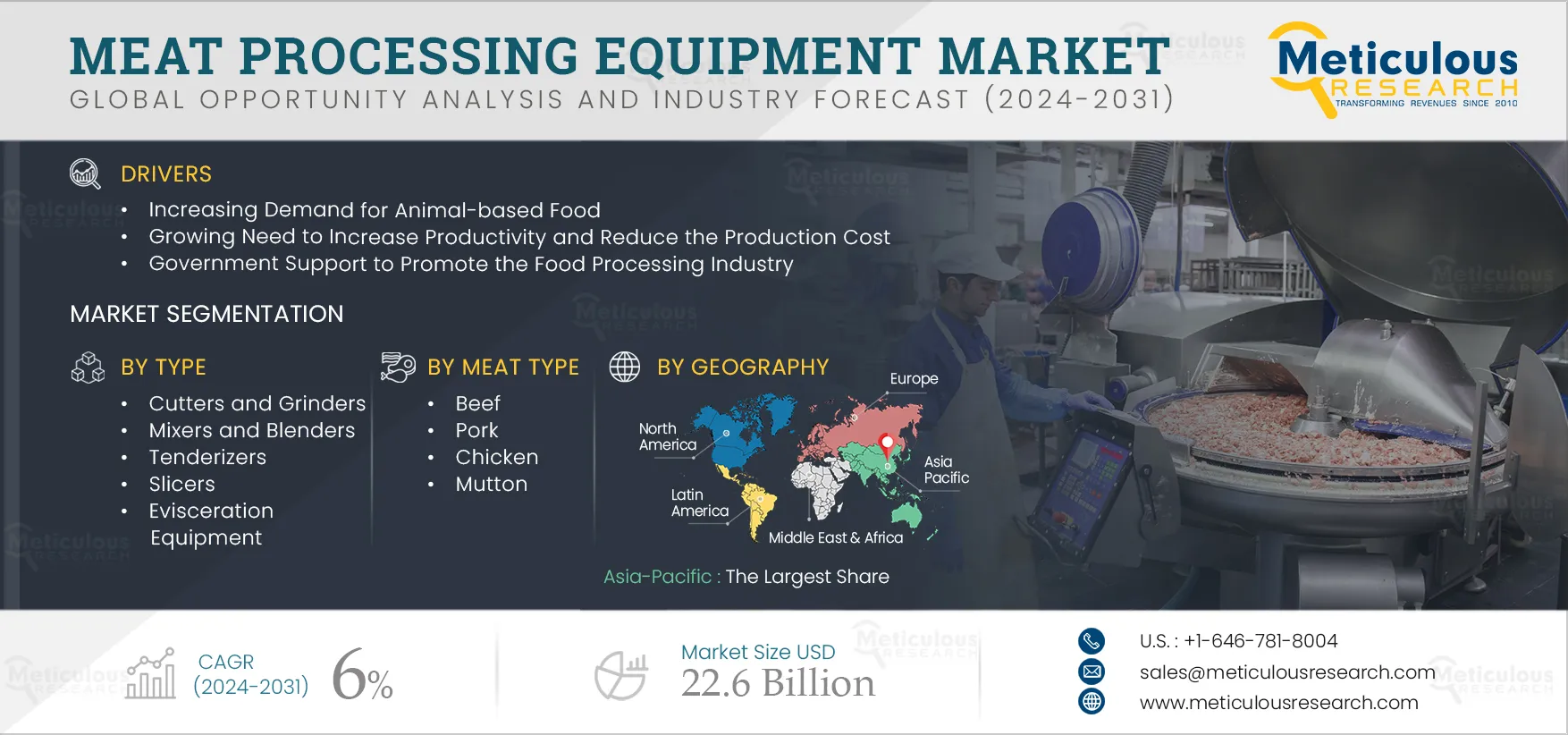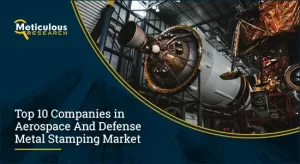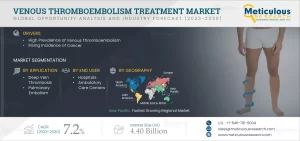
In an era where the global food landscape is rapidly evolving, the meat processing equipment market has emerged as a vital segment within the food processing industry. A recent report by Meticulous Research® highlights that the market for meat processing equipment is poised to reach an impressive $22.6 billion by 2031, growing at a CAGR of 6% from 2024 to 2031. This anticipated growth is driven by several interrelated factors, including an increasing demand for animal-based food, heightened productivity needs, and supportive governmental policies aimed at advancing the food processing sector.
Download Sample Report Here @ https://www.meticulousresearch.com/download-sample-report/cp_id=5760
Market Dynamics: Drivers and Challenges
Key Growth Drivers
- Increasing Demand for Animal-Based Food
The global appetite for meat continues to rise, driven by population growth and changing dietary preferences. With meat being a significant source of protein, its demand is expected to surge, necessitating advanced processing equipment to meet this demand efficiently. - Need for Enhanced Productivity
As the meat processing industry faces pressure to produce more while maintaining quality, there is a pressing need for innovative machinery that can streamline operations. Automation and semi-automated equipment enhance labor productivity and operational efficiency, allowing producers to maximize output while minimizing costs. - Government Support
Many governments worldwide are implementing policies to promote the food processing industry, recognizing its crucial role in ensuring food security and economic development. This support is instrumental in providing manufacturers with the necessary tools and infrastructure to thrive. - Technological Advancements
Continuous innovations in meat processing equipment, including the introduction of smart technologies, have improved the efficiency and effectiveness of food processing. These advancements enable manufacturers to create diverse products while ensuring safety and quality.
Market Restraints
While the market’s growth prospects are promising, certain challenges could hinder progress:
- High Equipment Costs
The significant investment required for modern meat processing equipment can be a barrier, especially for small and medium-sized enterprises. Many potential players may be deterred by the initial costs associated with upgrading or investing in new machinery. - Lack of Skilled Labor
The rapid advancement of technology in meat processing has created a demand for skilled labor capable of operating sophisticated machinery. However, a shortage of trained personnel in many regions poses a challenge to market growth.
Market Segmentation Analysis
The meat processing equipment market can be analyzed through various segments, including equipment types, modes of operation, meat categories, and geographical distribution.
Equipment Types
According to the report, the cutters and grinders segment is expected to dominate the market in 2024. The increasing global meat production and consumption rates, coupled with the versatile application of these machines in various meat products, contribute to this segment’s robust market share. Other significant equipment types include:
- Smokers, Massagers, and Tumblers
- Mixers and Blenders
- Tenderizers
- Killing and Defeathering Equipment
- Slicers
Modes of Operation
In 2024, the semi-automatic segment is projected to account for the largest share of the meat processing equipment market. This trend can be attributed to the operational advantages offered by semi-automatic machinery, such as improved labor productivity and flexibility in production processes.
Meat Categories
The processed meat segment is anticipated to hold a substantial share of the market, fueled by the increasing demand for ready-to-cook food products. Additionally, technological advancements in processing equipment are fostering innovation, making processed meat a key growth area.
Meat Types
Focusing on meat types, the beef segment is expected to lead the market in 2024, driven by a robust demand for beef as a primary protein source. Consumer preferences lean towards beef due to its higher nutritional content compared to other meat varieties, such as poultry and pork. The trend is further supported by rising awareness of protein consumption and health-related concerns associated with other meats.
Get A Glimpse Inside: Request Sample Pages – https://www.meticulousresearch.com/request-sample-report/cp_id=5760
Geographic Distribution
Geographically, the Asia-Pacific region is projected to register the fastest growth from 2024 to 2031. The growing emphasis on protein-rich diets, coupled with rapid urbanization and rising disposable incomes in developing countries like China and India, significantly drives this growth. Consumers in these regions are increasingly opting for convenient ready-to-cook meat products, further bolstering market expansion.
Competitive Landscape
The meat processing equipment market features a moderate level of competition, characterized by the presence of both large and small players. Key market players include:
- GEA Group Aktiengesellschaft (Germany)
- Marel HF (Iceland)
- John Bean Technologies Corporation (U.S.)
- The Middleby Corporation (U.S.)
- Mepaco Group (U.S.)
- Minerva Omega Group s.r.l (Italy)
- Heat and Control Inc. (U.S.)
- Alfa Laval AB (Sweden)
- Equipamientos Cárnicos, S.L (MAINCA) (Spain)
- Biro Manufacturing Co (U.S.)
- Nordischer Maschinenbau Rudolf Baader GmbH & Co. KG (Germany)
These companies are continually innovating and investing in new technologies to maintain their competitive edge, enhancing their market share through strategic partnerships, mergers, and acquisitions.
Future Outlook
The future of the meat processing equipment market appears promising, with several trends likely to shape its trajectory over the next decade:
- Shift Towards Automation
As labor costs rise and the demand for efficiency increases, more companies are expected to adopt fully automated systems. This shift will not only optimize production but also improve product consistency and quality. - Sustainability Initiatives
With growing awareness of environmental issues, meat processing equipment manufacturers are likely to focus on sustainability. Innovations aimed at reducing waste, energy consumption, and water usage will be pivotal in attracting environmentally conscious consumers. - Health and Safety Regulations
The meat processing industry must continually adapt to stricter health and safety regulations. Companies that invest in advanced machinery that meets or exceeds these standards will likely gain a competitive advantage. - Emerging Markets
Emerging economies in Latin America, Southeast Asia, and Africa present significant growth opportunities. As these regions develop, their demand for meat processing equipment will increase, driven by changing dietary habits and urbanization. - Integration of Smart Technologies
The adoption of the Internet of Things (IoT), artificial intelligence (AI), and machine learning will revolutionize meat processing. These technologies can facilitate real-time monitoring of production processes, enhancing efficiency and reducing errors.
Conclusion
The meat processing equipment market is on the cusp of transformative growth, driven by a confluence of factors including rising demand for meat, technological advancements, and government support. While challenges such as high equipment costs and a shortage of skilled labor persist, the industry’s adaptability and innovation will likely propel it forward.
As we move toward 2031, the continued evolution of consumer preferences, regulatory landscapes, and technological advancements will play crucial roles in shaping the future of the meat processing equipment market. Companies that remain agile and responsive to these changes will be best positioned to thrive in this dynamic and competitive landscape.
As a result, the meat processing equipment market is not just a reflection of changing dietary habits but also an indicator of broader trends in technology, sustainability, and global commerce. It stands as a critical pillar of the food processing industry, ensuring that the world’s growing population has access to nutritious and high-quality meat products.
Immediate Delivery Available | BUY THIS RESEARCH REPORT (Insights, Charts, Tables, Figures and More) – https://www.meticulousresearch.com/Checkout/43709837
Segment Covered
By Type
- Cutters and Grinders
- Smokers, Massagers, and Tumblers
- Mixers and Blenders
- Tenderizers
- Killing and Defeathering Equipment
- Slicers
- Evisceration Equipment
- Cookers, Roasters, and Grillers
- De-heading and Gutting Equipment
- Other Meat Processing Equipment
By Mode of Operation
- Semi-automatic
- Automatic
By Category
- Processed Meat
- Fresh Meat
By Meat Type
- Beef
- Pork
- Chicken
- Mutton
- Other Types of Meat
Contact:
Meticulous Market Research Pvt. Ltd.
1267 Willis St, Ste 200 Redding,California, 96001, U.S.
USA: +1-646-781-8004
Europe: +44-203-868-8738
APAC: +91 744-7780008
Email– sales@meticulousresearch.com
Visit Our Website: https://www.meticulousresearch.com/
Connect with us on LinkedIn- https://www.linkedin.com/company/meticulous-research







